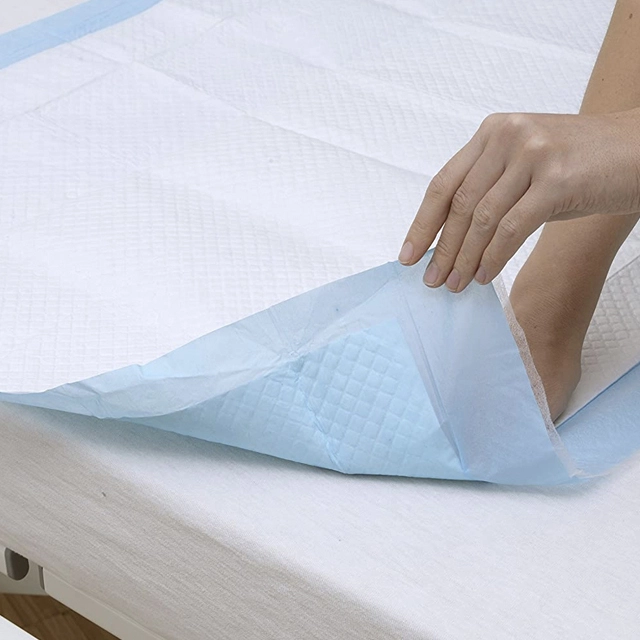When it comes to managing incontinence or protecting bedding from spills, understanding the differences between bed pads and underpads is crucial. Both products serve the purpose of safeguarding surfaces from moisture, but they are designed with distinct features and functionalities. In this comprehensive guide, we will delve into the nuances of bed pads and underpads, highlighting their unique characteristics, benefits, and ideal use cases.
Bed pads, also known as chux pads or bed protection pads, are a type of absorbent pad specifically designed for use on beds and other sleeping surfaces. These pads are essential for individuals who experience incontinence, are recovering from surgery, or require additional protection due to various medical conditions.
Absorbency: Bed pads are designed with high absorbency in mind. They typically feature multiple layers, including a top layer that draws moisture away from the skin, a middle layer that retains moisture, and a bottom layer that prevents leakage. This construction ensures that the bed remains dry and comfortable.
Size and Shape: Bed pads come in various sizes to accommodate different bed dimensions and user needs. Common sizes include standard twin, full, queen, and king. They often have a rectangular shape that fits the surface of a mattress.
Material: The materials used in bed pads are chosen for their comfort and absorbency. They usually include a soft, non-woven fabric on top, an absorbent core (often made from fluff or gel), and a waterproof backing to prevent leaks.
Reusability: While some bed pads are disposable, many are designed for reusability. Washable bed pads can be cleaned and reused multiple times, making them a cost-effective and environmentally friendly option.
Enhanced Comfort: The soft top layer of bed pads ensures a comfortable sleeping experience, while the absorbent core keeps moisture away from the skin.
Protection: Bed pads protect mattresses from stains and odors, extending the life of the bedding.
Convenience: Reusable bed pads can be easily washed and maintained, reducing the need for frequent replacements.
Underpads, often referred to as chux pads or incontinence pads, are versatile absorbent pads used for various applications beyond just beds. They are commonly used in medical settings, as well as in home care situations, to provide protection against moisture and spills.
Absorbency: Similar to bed pads, underpads are designed to absorb moisture effectively. They feature a multi-layer construction, including a top layer that wicks away moisture, a middle absorbent layer, and a waterproof backing to prevent leaks.
Size and Shape: Underpads come in a range of sizes and shapes to fit different needs. They can be found in small, medium, and large sizes, and are often designed to be used on various surfaces, such as chairs, wheelchairs, and beds.
Material: Underpads are made from similar materials to bed pads, including soft top fabrics, absorbent cores, and waterproof backings. The choice of materials ensures both comfort and functionality.
Reusability: Underpads are available in both disposable and reusable versions. Disposable underpads are convenient for single-use scenarios, while reusable options are ideal for regular use and can be washed and reused multiple times.
Versatility: Underpads can be used in a variety of settings, including beds, chairs, and other surfaces. This versatility makes them a valuable addition to any incontinence management routine.
Protection: They provide reliable protection against moisture, helping to maintain cleanliness and hygiene in various environments.
Ease of Use: Disposable underpads are convenient for quick changes, while reusable underpads offer a sustainable and cost-effective solution.

While bed pads and underpads share similar functions, they differ in several key aspects:
Primary Use: Bed pads are specifically designed for use on beds and are typically larger in size to cover the mattress. Underpads are more versatile and can be used on various surfaces, including beds, chairs, and wheelchairs.
Design and Construction: Bed pads often have a larger surface area and may include features such as extra absorbent layers or contouring to fit the mattress. Underpads are designed to be more adaptable and may come in smaller sizes to fit different applications.
Cost and Maintenance: Both bed pads and underpads are available in disposable and reusable versions. Reusable options for both types offer cost savings and environmental benefits. However, the specific cost and maintenance requirements can vary based on the product's design and intended use.
When selecting between bed pads and underpads, consider the following factors:
Purpose: Determine where and how the product will be used. If you need protection for a mattress, bed pads are an ideal choice. For versatility in various settings, underpads may be more suitable.
Absorbency Needs: Evaluate the level of absorbency required based on individual needs. Both bed pads and underpads offer different absorbency levels to suit different scenarios.
Budget: Consider the cost of disposable versus reusable options. Reusable products generally offer long-term cost savings.
In summary, both bed pads and underpads offer essential protection against moisture and spills, but they are designed for different purposes and applications. By understanding the differences and benefits of each, you can make an informed decision that best suits your needs.